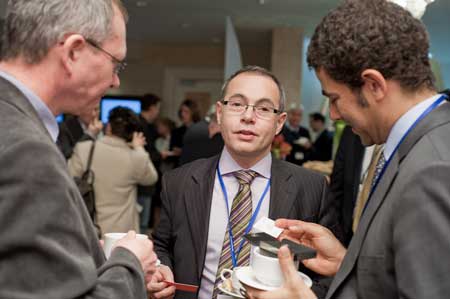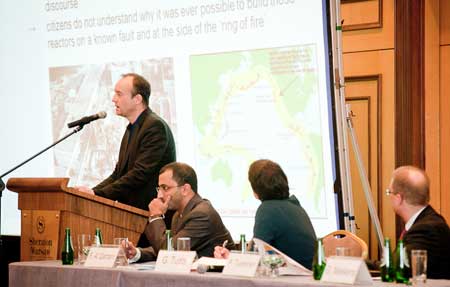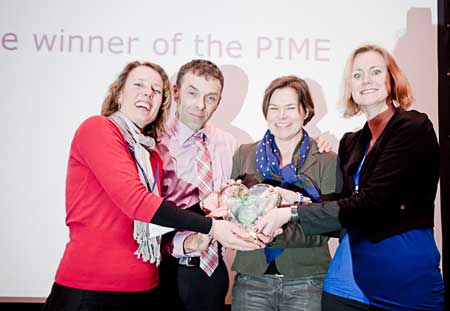PIME 2012: A Young Generation report on Europe’s N° 1 conference for nuclear communicators
PIME (Public Information Materials Exchange) is an annual conference aimed at improving communications in the nuclear sector. The main aim of the conference is to share knowledge on communications tools and strategies and to exchange ideas and network with colleagues from the nuclear field in order to increase public acceptance of the nuclear industry worldwide. PIME 2012 took place in Warsaw from 12-15 February. 170 nuclear communicators and young professionals from all over the world took part.

The focus of this year´s PIME-conference was the accident at Fukushima and its consequences for Europe and the whole world, especially regarding nuclear new build projects.
The event started on 12 February, with a short press conference and a Welcome Drink.
On 13 February, after the Opening Address and a presentation from the host country, the first Plenary Sessions got under way. It was dedicated to an analysis of how communicators met the challenge of Fukushima. The President of the Japan Atomic Industrial Forum (JAIF), Takuya Hattori outlined what exactly happened at the plant, what was communicated and how. Mr. Hattori explained that the biggest problem that communicators faced following Fukushima was that the information released was communicated too late and, initially, was too difficult to understand. In short, the information released from Japan was too late, inconsistent, unclear, too technical and fragmentary. This information policy also prompted reactions from overseas including, for example, the cancellation of events and the evacuation of people and embassies in response to the accident.
The challenge for communicators, especially in the nuclear field, is to provide rapid credible, accurate and easy-to-understand information. To achieve this goal it is necessary to use all the methods and tools of communication, especially new social media, like internet-blogs.
The next speaker was Professor Tim van der Hagen from Delft University of Technology, in the Netherlands. He explained the role that scientific stakeholders played in the first days after the accident. The big problem they faced was that the media wanted to write about worst case scenarios, but serious scientists have to stick to the facts. So scientists have been replaced in the media by pseudo-experts. These people are taken as seriously as scientists, especially because the public suspects that there are links between industry and scientists, so trust in scientists is not always a given. Professor van der Hagen’s presentation ended with a focus on the interesting question of whether scientists should stick to the facts and risk not being believed, or speculate on the worst case scenarios and be taken seriously by the public and the media. The answer from the audience was that it is necessary to do both. Although it is not serious from an academic point of view to comment on or draw worst case scenarios, it’s a necessary process. If scientists and experts don’t comment on the worst case scenarios presented in the media, some pseudo-experts will fill the resultant void and be taken seriously by the public and the media.
Gill Tudor, Spokesperson and Head of Media Outreach at the IAEA, then explained the communications role that the IAEA fulfilled during and after the accident. It was remarkable because it was the first time that new media like Facebook, Twitter, Youtube or Flickr were used to inform people. The problem of using these new media is that factually verified information cannot be delivered as quickly as video clips. For example, consider the hydrogen explosions that occurred in Fukushima: minutes after they occurred, every TV station in the world was showing videos of the explosions. Everyone wanted to know what had happened, but nobody could provide verified information as quickly as the media and the public demanded. Once again, pseudo-experts speculated about nuclear explosions having occurred that were similar to those at Chernobyl.
Walter Hill, Senior Director of External Communications at the Nuclear Energy Institute (NEI), USA, also highlighted the importance today of exploiting social media and new media outlets. On the first day after the accident a special webpage was created and telephone and fax hotlines were installed. On that first day zero calls and faxes were received. But during the first month after the accident 45.000.000 clicks on the newly created webpage were registered. This is further evidence of how important it is to work with new media.
The second Plenary Session focused on the question of how events in Japan affected public acceptance of nuclear. The speakers where Joseph Milton from the Science Media Centre, UK; Christian Legrain, Secretary General of SCK-CEN, Belgium and Dr. Ephraim Gräff, from the Germany utility E.ON. It was very interesting to discover that in December 2011, in most countries, the level of public opinion in favour of nuclear was about the same as it was before Fukushima. One reason for this is that the worst case scenarios envisaged by the “gutter press”, like the evacuation of the whole of the northern part of Japan, had not materialised. Once again, this stressed how important it is to communicate: the general advice given was “Be ready to speak to the media because otherwise someone else will do it.”
After lunch three parallel workshops took place. They were entitled:
- YGN: Preparing for nuclear new build: get on the bus!
- Do you want to know more about electricity production and energy?
- Internal communications at a time of crisis
The workshops where followed by presentations by the 5 short-listed candidates for the 2012 PIME Award for Communications Excellence. The five short-listed campaigns “sold” to Pimers were as follows: The first one was a Russian project called the Train of Innovation, which centred on a train that travelled throughout Russia informing people along the way about nuclear energy, like a mobile nuclear information centre.
The second campaign, which was organised by the French branch of WiN (Woman in Nuclear), promoted special educational tools aimed at helping children to learn more about nuclear and providing teachers with didactic support. The Q&As that featured in the campaign used the language of teenagers, which increased young people’s access to and interest in basic information about nuclear.
The third shortlisted campaign was from the Netherlands. A team from the NRG (the Dutch national nuclear research consultancy), which is responsible for running the research reactor at Petten, in the Netherlands, presented their campaign, entitled Forward thinking, giving nuclear a human face. It communicated what the nuclear future could look like in 50 years’ time. Another important component of the campaign was the information that was communicated to the public about the vital role that nuclear energy plays in providing life-saving health care provision.
The fourth campaign presented was from Austria. A team from the Austrian Young Generation section of the Austrian Nuclear Society described the campaign behind the book they had written about the core question with regards to nuclear power, entitled: What happens when something happens? The book was written after the Fukushima accident in order to inform the public, in a serious way, about nuclear energy. One issue highlighted was how the public, especially in German-speaking countries, is misinformed about nuclear energy production and how the information is mostly given to the public by the gutter press and nuclear opponents.
The final short-listed campaign presented came from the Emirates Nuclear Energy Corporation (ENEC), from the United Arab Emirates. It involved a public information project that ENEC had launched aimed at people living in the UAE, which was necessary because nuclear was something completely new to them. This information campaign was especially important after the accident in Fukushima, because people had legitimate questions that ENEC needed to answer. The project increased the credibility of the industry with the public. So the UAE started where other countries have stopped.
That evening a Gala Dinner took place at the Palace of Culture and Science in Warsaw. The choreography from the waiters who served the delicious food really excited the participants. The evening concluded with dancing and drinks in a bar.
On the second day, the results of the previous day’s workshops were presented. This was followed by the third Plenary Session, which was entitled: Nuclear has a future – new build still on track in Europe. Jean-Pol Poncelet, Secretary General of ENS and Director General of FORATOM, gave an overview of the new build projects in the world. 64 reactors are currently under construction, 16 of them in Europe. John McNamara, from NuGen, UK, then presented the communications strategy behind the British new build project. In the UK 8 approved sites have been approved where approximately 13.000 MW will be generated by 2025. Four of the units will be EPR’s.
Dorota Chandavoine, from the Polish utility PGE, presented the communications strategy of Poland’s new build project. The aim of the strategy is improve the knowledge of the public, because knowledge leads to understanding and understanding leads to acceptance and support.
After the third plenary session a further 3 parallel workshops took place, developing the following themes:
- Media training
- WiN: Learning more about nuclear safety and legal issues after Fukushima
- Other industries
After lunch the fourth Plenary Session took place, focusing on the topic Learning the lessons of Fukushima: cliché or reality? Gaston Meskens, Researcher from the Centre for Ethics and Value Inquiry (CEVI) from the University of Gent, explained how to improve the learning process. After that, Peter Tuominen, Manager of Development and Communications at FORTUM, Finland, talked about delivering the right messages to an interested public.

The last presentation was given by Fahad Al Qahtani, Director of External Affairs and Communications at ENEC, who explained how Fukushima had changed their communications focus. They found themselves in the unique situation where Fukushima happened exactly at a time when high-ranking politicians and businessmen were visiting the construction site and a big party had been planned. After, or rather during the Fukushima accident, they had to change their information policy. Information about Fukushima was more important at that time than information about the new build project. It was also important to tell the public about the differences between the situation in Japan and the likelihood of a similar scenario happening in the United Arab Emirates, especially with regards to earthquakes and tsunamis.
After the fourth and final plenary session, the results of the workshops from the second day were presented. This was followed by the Closing Session, where Jean-Pol Poncelet reflected upon how nuclear communicators can get the right messages across bearing in mind what happened in Japan. Mr. Poncelet then announced the winner of the 2012 PIME Award for Communications Excellence. It was NRG from the research reactor in Petten, the Nederlands, for its Forward thinking, giving nuclear a human face campaign. As a farewell glass of champagne was being served, the location for PIME 2013 was announced. Next year PIME will take place in Switzerland.

"NRG wins the 2012 PIME Award"
The next day the Austrian Nuclear Society delegation joined other participants in a tour of the Polish research reactor, MARIA, near Warsaw. We had the opportunity to visit the reactor while it was working at 90% of its nominal power and see all the facilities at the research centre, including the manufacturing of medical equipment, the decommission of the old research reactor, the storage of the spent fuel and the well-equipped information centre.
In the afternoon, we went back to the hotel.
For three days PIME brought together many important communicators in the nuclear sector. The conference showed how important it is to communicate with the public, especially since the Fukushima-accident. Nearly everyone has an opinion on nuclear issues, but only few people are well-informed about the facts. The better the public is informed, the more they will support or at least accept nuclear projects.
PIME 2012 showed me, as an engineer, how important it is to communicate with the public, especially on complex technologies, like nuclear technology. Misinformed people are afraid of nuclear, and people who are afraid are usually against it.
Oliver Siegl
ÖKTG – Austrian Nuclear Society
Austria

